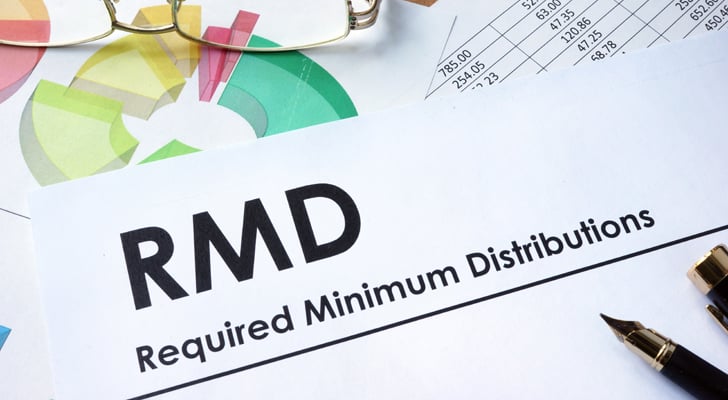Editorial Note: InvestorPlace Beacon independently determines what we cover and recommend. We earn a commission from affiliate partners on many offers and links. However, these commissions do not affect our editors' opinions or evaluations. Click here to read our full advertiser disclosure.

Source: Shutterstock
Required minimum distribution (RMDS) are the minimum amounts the IRS requires you to withdraw from specific retirement accounts annually. Whether you need to take a RMD — and how large that withdrawal needs to be — is determined by the type of retirement savings account and your age. Learn more about how RMDs work, how they’ll affect you and how to determine when and how much you’ll need to withdraw.
Understanding RMDs
Many retirement accounts allow you to defer taxes while your funds grow and only pay taxes at the time of withdrawal. RMDs require you to withdraw a minimum amount from specific retirement accounts each year to ensure that Uncle Sam collects on the money you owe. Generally, you need to start taking RMDs from your retirement accounts when you turn 72 (or 73 if you reach age 72 after Dec. 31, 2022).
The following retirement accounts come with RMDs:
- 401(k) plans
- 403(b) plans
- 457(b) plans
- Profit sharing plans
- Other defined contribution plans
- Traditional IRAs
- SIMPLE IRAs
- SEP IRSs
- SARSEPs
The Secure 2.0 Act came with several changes to RMD rules. Starting in 2024, designated Roth IRA accounts no longer require RMDs. However, you’ll still need to take RMDs from designated Roth accounts for 2023, including those with a required beginning date of April 1, 2024, and beneficiaries of Roth IRAs still need to take RMDs. The legislation also increased the age at which you need to start taking RMDs to 73 from 72 — and that will jump to age 75 in 2033.
The amount you withdraw will be taxed at your current income tax rate. If you have multiple IRAs, you need to calculate the RMD separately for each account, but you can withdraw the total amount from one or more IRAs. However, RMDs for other types of retirement accounts, like 401(k)s, must be taken out separately from each of those accounts.
| Did you know? |
| You can withdraw more than the minimum amount, but the excess amount will not go toward next year’s RMDs. |
Source: IRS
RMD Penalty
It’s important to keep track of the deadline for taking RMDs, since failing to make the withdrawals will result in a penalty. If you don’t withdraw the full RMD from your account by the due date, the amount not withdrawn is subject to a 25% excise tax.
However, if you manage to fix the RMD error within two years, the excise tax drops to 10%. If you made an honest mistake withdrawing the wrong amount, the excise tax can be dropped to 0%, if you can provide the IRS with a proper explanation and filed paperwork.
For example, if you were supposed to withdraw $50,000, but only withdrew $20,000. The remaining $30,000 still in your account will face the 25% excise tax, and you’ll owe $7,500. If you correct your mistake within two years, you’d owe $3,000.
| Did You Know? |
| If you made an error accidentally withdrawing the wrong amount, the IRS could waive the penalty tax altogether. To waive the penalty, you must file Form 5329 and attach a letter of explanation. |
How to Calculate Your RMD
Your IRA custodian or retirement plan administrator may calculate the RMD for you. However, you’re ultimately responsible for ensuring you’re withdrawing the right RMD amount.
IRAs, 401(k)s and other retirement plans use the following formula to calculate the RMD amount:
- Take your account’s balance as of Dec. 31 of the previous year.
- Find the IRS’ distribution period matching your age for the current year.
- Divide your account’s balance by the distribution period to calculate your RMD amount.
The IRS has different worksheets available to help you determine your distribution period and RMD amount due. Most use the Uniform Lifetime Table, which is depicted below.
| Age | Distribution period | Age | Distribution period |
| 72 | 27.4 | 81 | 19.4 |
| 73 | 26.5 | 82 | 18.5 |
| 74 | 25.5 | 83 | 17.7 |
| 75 | 24.6 | 84 | 16.8 |
| 76 | 23.7 | 85 | 16.0 |
| 77 | 22.9 | 86 | 15.2 |
| 78 | 22.0 | 87 | 14.4 |
| 79 | 21.1 | 88 | 13.7 |
| 80 | 20.2 | 89 | 12.9 |
RMD Calculation Example
Let’s say Edward, a 75-year-old retiree, has an IRA with a balance of $250,000 on Dec. 31 of the previous year.
By matching his age to the chart above, we know his distribution period is 24.6. Edward can determine how much he needs to withdraw by dividing $250,000 by 24.6, which is $10,162.60.
If Edward withdraws the $10,162.60 RMD from his IRA by the deadline, he won’t face any penalties.
Note that this example is for an IRA using the Uniform Lifetime Table. You may have to use a different formula and table. Consider speaking to a licensed financial advisor if you’re not sure which table to use.
When RMDs Are Due
RMDs are due on Dec. 31 each year, starting when you turn 72 (or 73 if you turn 72 after Dec. 22, 2022). However, you can delay taking your first RMD until April 1 of the following year.
If you own a workplace retirement account, such as a 401(k), you can delay taking RMDs until the year you retire if your plan allows.
Sources:
IRS. (2024, February 28). Retirement plan and IRA Required Minimum Distributions FAQs. Retrieved from https://www.irs.gov/retirement-plans/retirement-plan-and-ira-required-minimum-distributions-faqs
IRS. (2023, November 3). IRA Required Minimum Distribution Worksheet- Spouse 10 years Younger\. Retrieved from https://www.irs.gov/retirement-plans/plan-participant-employee/ira-required-minimum-distribution-worksheet-spouse-10-years-younger



